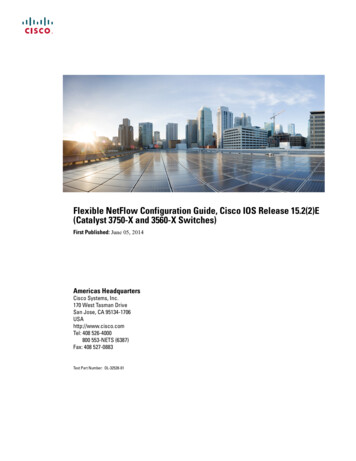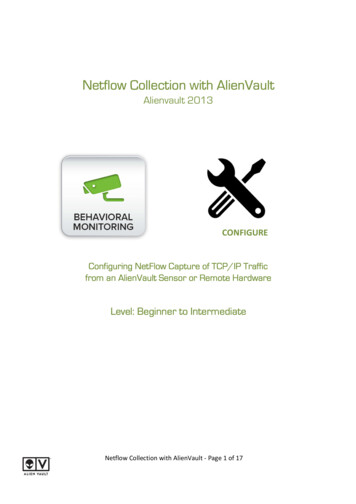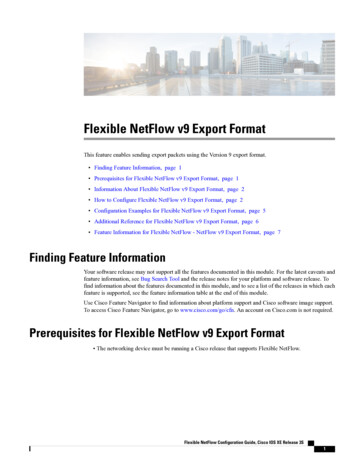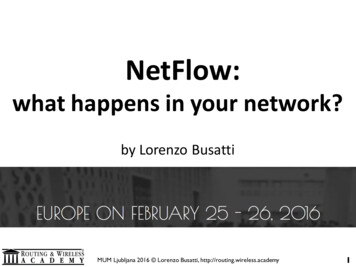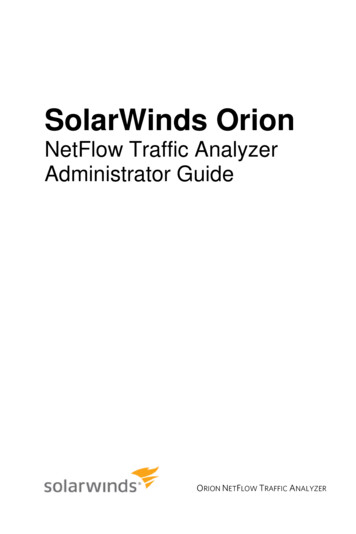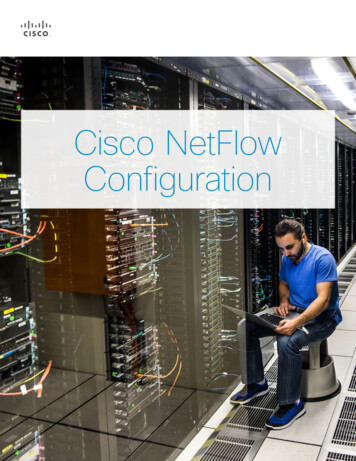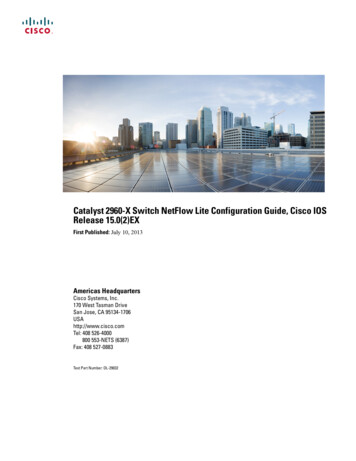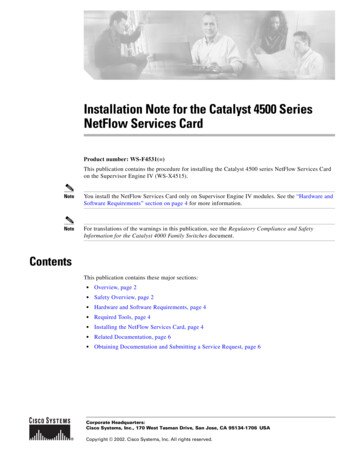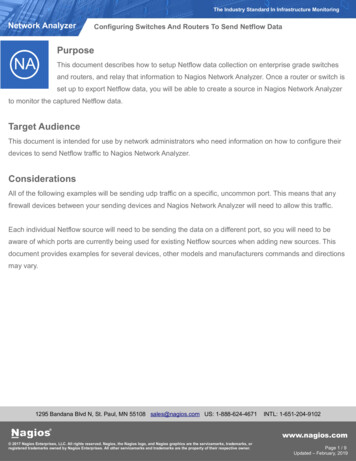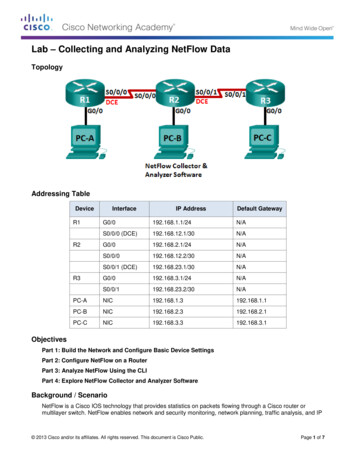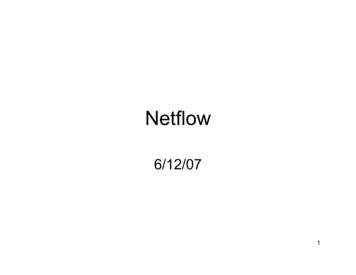
Transcription
Netflow6/12/071
Overview Why use netflow?What is a flow?Deploying NetflowPerformance Impact2
Caveats Netflow is a brand name like Kleenex. Itwas developed by Cisco Juniper uses the term cflowd for flowexport The term “netflow” will be used generically NETS, as of this presentation, only exportsflow data from Junipers Application configuration is beyond thescope of this presentation3
Why Use Netflow? EnterpriseInternet– protocol distribution– monitor users/applications– identify malicious traffic Service Provider–––––NCARpeeringIdentify malicious trafficplanningtraffic engineeringaccounting/billing4
The solution: Netflow Developed and patented by Cisco in 1996 Classifies network traffic into “flows” byinspecting packets at layers 2 – 4. Currently on standards track - IPFIX “Flows” can be analyzed to providenetwork and security monitoring, networkplanning, traffic analysis and IPaccounting.5
What is a flow?As defined by the IPFIX WG A flow is defined as a set of IP packetspassing an observation point in thenetwork during a certain time interval. Allpackets belonging to a particular flow havea set of common properties A packet isdefined to belong to a flow if it completelysatisfies all the defined properties of theflow.6
Flow ExampleObservation point:router or multilayer switchCommon properties1.A flow is unidirectional2.Defined by inspecting a packet’s key fields (common properties) andidentifying the values3.If the set of key field values is unique create a flow record or cache entry7
Flow example: part 2FTP ServerFTPFTPPCHTTPWeb Server8
Netflow Export Versions Multiple netflow export options (v1, v5, v7, v8,v9). Each version defines their own “commonproperties” and export packet format Most common is v5 v7 specific to 6500s (now obsolete) v8 allows aggregation v9 (aka flexible netflow) used as basis forupcoming IPFIX (IP flow information export)standard. User defined.9
Other Exported fields In addition to the key fields, the following nonkey fields are exported in netflow v5:–––––source and destination ASssource and destination IP subnet masksIP address of next-hop routerTCP flagsoutput interface A list of all exported fields can be found twk/intsolns/netflsol/nfwhite.htm#wp109596510
Deploying Netflow Overview – Typical Deployment Basic steps to Deploy Netflow– Determine which routers/interfaces to enablenetflow– Configure Routers Juniper Cisco– Setup netflow collectors– Choose and configure an application11
Overview - Typical DeploymentInternetpoExlowrt ftadaBorderrouterEnterpriseEnd userNetflow Collector &Application Server12
Determine which routers/interfacesto enable netflow Enable netflow onselected interfaces tocapture allinbound/outboundtraffic Neflow only enabledinbound on aninterface Avoid doublecounting!!Internet Netflow enabledinterface inbound traffic outbound trafficGinFlra/bNCARMlra/b13
Configure Routers/Switches Juniper––––Create a firewall filterApply the filter to an interfaceConfigure samplingConfigure netflow data export Cisco– Enable netflow/sampled netflow– Enable interfaces for sampled netflow (un-samplednetflow automatically applied to all interfaces)– Configure netflow data export– Configure netflow cache timers14
Configure Router – Juniper M20Architecture Two ways to configure netflow– basic or advanced.Advanced would require anASP2 PIC – list price 35k.NETS uses the basic config. Basic netflow config – netflowruns as a unix process on RE.Limited by 8000pps across theRE to Forwarding Board 100Mbps Ethernet link (not afactor if using ASP2) No support for v9 with basicnetflow15
Configure Routers – Juniper M20Create & Apply Firewall Create Firewall using the key term “sample”.firewall {filter NCARInput {term CatchAll {then {sample;accept;}}} Apply Firewall to interfaceinterfaces {ae0 {unit 303 {description "------------------------------ link with mlra and mlrb";vlan-id x;family inet {mtu 9000;filter {input NCARInput;output NCAROutput;}address x.x.x.x/29;}}16
Configure Routers – Juniper M20Sampling and Export Configure Sampling:–Sampling Rate (run-length 1) /rate–max-packets-per-second - themaximum number of packets to besampled Configure output Cflowd – IP address of flow collector Port – set the UDP port the collectoris listening for netflow data. Version – set the flow export version No-local-dump – do NOT write flowfiles to disk before exporting Autonomous-system-type [peer orgin]– write the specified AS number inflow export file.Sampling & Export config from Gin:forwarding-options {sampling {input {family inet {rate 100;run-length 1;max-packets-per-second 1000;}}output {cflowd x.x.x.x {port xxxx;version 5;no-local-dump;autonomous-system-type peer;}}}}17
Configure Router/Switch – Cisco 6500Architecture 1st packet in flow sent to RP,software switched. All other packets in flowswitched in hardware. Must enable netflow inhardware and software. Flows stored in flow cache onrouter18
Configure Router/Switch – Cisco 6500Enable Netflow/Sampled Netflow Global config, enable sampled netflowin hardware, 1 out of 64 packets. Configure the flow mask, “interfacefull” required for sampled netflow inhardware Per interface, enable sampled netflowin hardware. Per interface, enable sampled netflowin softwareC6500(config)# mls sampling time-based64C6500(config)# mls flow ip interface-fullC6500(config)# interface Gx/xC6500(config-if)# mls netflow samplingC6500(config-if)# ip flow ingress19
Configure Router/Switch – Cisco 6500Netflow Data Export (NDE) Set the NDE version Populate the following additionalfields in the NDE packets– Egress interface SNMP index– Source-autonomous systemnumber– Destination-autonomoussystem number– IP address of the next-hopC6500(config)# mls nde senderversion 5C6500(config)# mls nde interfacerouter Configure NDE export destination (ipaddress) of collectorC6500(config)# ip flow-exportdestination x.x.x.x20
Netflow Collector NETS uses a freeware version called flow-tools writtenby Mark Fullmer Collects and aggregates data from multiple routers andwrites it to a file for processing by a netflow application. Typical configuration looks like this:– /usr/bin/flow-capture -w /var/netflow/flows 0/0/9996 –z0 –V5 E1G -n 287 -N 0 -w0/0/9996-z0-V5-E1G-n 287-N 0Store flows in /var/netflow/flowsAccept data from any source sending to port 9996Compression level, 0 no compressionPDU versionRetain max # of flow files up to 1 GbNumber of times per day a flow file will be created (5min)Nesting level for storing flow files21
Netflow Applications NETS uses Flowscan developed by DavePlonka at UW.– Report Modules CampusIO – shows traffic in/out through a peeringpoint or border router. SubnetIO – shows traffic in/out per defined subnet TopN – reports the top talkers Cisco CLI22
Flowscan – NCAR BPS23
Flowscan – NCAR Flows24
Flowscan – NCAR Packets25
Flowscan – NCAR TopTalkers26
Netflow Applications – Cisco CLI27
Current NCAR Netflow DeploymentLevel3ICGFRGP WANNLRQwestBison ARMIXAbileneComcastUCBBison BCOBGINNLR AFLRA/BMLRA/BIthakaDUCSMUWNLR BtaNCARdat HSCStateBison ABison BFRGP LANNetflow.ucar.eduExport flow dataFlowscan.frgp.net Netflow not enabled28
Performance Impact – Juniper CPU -Initial spike on RE process when new interfaces are enabled. Memory – none, does not keep state (cache) Limited by 8000pps across the RE to Forwarding Board 100 MbpsEthernet link– ROT – 3 samples are bundled per packet; 3 *8k 24k maxsamples/sec. Look at all interfaces and total bps. Choose sampling rate 24k samples/sec Current BW used for export– Gin, 200kbps (1:100) Sampling– Frgp-gw-1, 10kbps (1:10000) Sampling Alleviate load problems by– using sampled netflow– Use firewall filters to include/exclude traffic– Enable on specific interfaces29
Performance Impact – Cisco 6500 CPU load - depends on number of flows andflow cache timer settings. Lower the timersetting, the higher the CPU because it isconstantly looking through the cache forflows to export.Memory -Netflow Cache– Timers: Inactive timer (Normal Aging) ; on 6k its defaultis 256 sec - should set it to 30 sec Active timer (Long Aging ); 32 minutes– PFC3B – can hold approx. 115k flow entries– if cache has to many flows then flows aredropped (lower Inactive timer) Alleviate load problems by–––––using sampled netflowUse flow masks on 65kUse “exclude” filters on 65kTweak timersEnable on specific interfaces.30
Future Move to v9/IPFIX Enable NDE on Cisco 65ks (tcom & L3gw). Send all export data to collectors.31
References Introduction to IP Accounting and Netflow, Cisco Networkers 2006.Juniper Networks Solutions for Network Accounting; Chuck Semeria,Marketing Engineer; Hannes Gredler, Professional Services feature-guide-80TOC.htmlCatalyst 6500 Series Cisco IOS Command er/products/hw/switches/ps708/products command reference chapter09186a00801ea88c.html#wp1179040 Check the flow-tools April 2007 mailing list for reasons on to enablesampling on the 65k switches.Juniper Networks Routing s/article.asp?p 30631&seqNum 232
Backup Slides33
v934
V5 Header35
V5 Flow Record, Part 136
V5 Flow Record, part 237
Competing Technologies SNMP – Simple Network Management ProtocolNBAR – Network Based Application RecognitionBGP PA – BGP Policy AccountingAAA – Authentication, Authorization, Accounting38
Netflow is a brand name like Kleenex. It was developed by Cisco Juniper uses the term cflowd for flow export The term “netflow” will be used generically NETS, as of this presentation, only exports flow data from Junipers Application configuration is beyond the scope of this presentation
